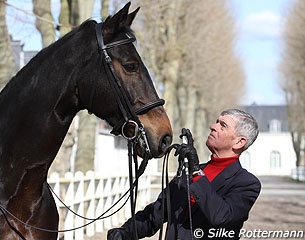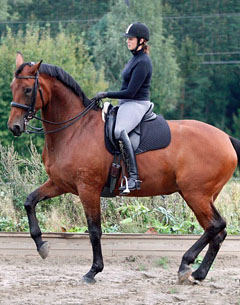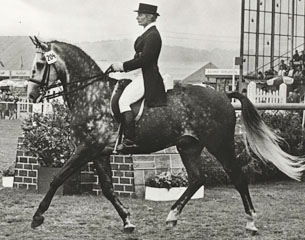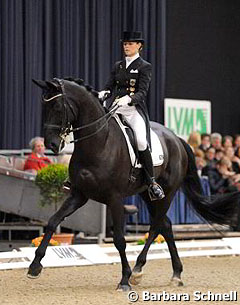
Our guest columnist of the week is Colonel Christian Carde, who has looked upon international dressage for more than 50 years as international competitor, French national coach and I-judge. The former chief rider of the Cadre Noir has been following the discussions about amending FEI rules regarding the position of poll with great interest. A recent column by Carl Hester in Horse and Hound prompted him to share his thoughts on the topic.
The Poll as Highest Point, Is it Still a Necessity?
The position of the poll in dressage horses has been a recurrent issue which recently got rekindled when Olympic champion Carl Hester wondered whether Article 401 of the FEI dressage rules on the head-neck-position of the horse in dressage competitions shouldn't be amended. The FEI Rule states that the properly trained horse should be presented with a more or less elevated and round neck, depending on the level of dressage, with the poll—as a general rule-- as the highest point, the nose slightly in front of the vertical. It is also in this position that all the great riders of the 20th century -- of all schools -- are shown on photo.
What is the motivation of a celebrated rider and trainer to amend article 401? Carl Hester himself states that the rules "need to take into account the range of breeds and shapes in dressage today." In his commentary in a January 2015 issue of Horse and Hound he asks if the poll should always be the highest point. He openly questions whether it is possible for Iberian horses with a big crest (citing the Lusitano Rubi as an example) can make the back and hind-legs work properly when the poll is actually the highest point.

poll as highest point!
(Photo © Minna Talberg)
So why did Carl Hester's comment cause such a discussion on the social media and internet? Probably because, unintended, he raised a topic that remains to be sensitive throughout the years: The poll as highest point.
Looking at horses in international dressage competitions most of them haven't got the poll as highest point anymore and so their attitude doesn't correspond with the rules, even though this doesn't hinder them to get high marks. It could be logical to amend the rule to the reality, but there are good reasons not to do so but continue demanding that horses of our days, of which most of them have much more refined necks than in the past, are presented with the poll as highest point.
Even though seen on numerous engravings and paintings from early on, the French écuyer Dupaty de Clam (18th century) was the first to have a methodic approach to the head-neck-position and stated that "nature favours the poll as the highest point because it contributes to the horse's balance."
Here is the point of the matter: It is irrefutable that to achieve the ideal balance, which is one of collection, that the horse has to engage the hindquarters and elevate his neck with the head just a bit in front of the vertical. Curiously one speaks more about the height of the poll than of the head-neck angle, which is without a doubt more important. Because a horse which is on the bit is one whose poll is supple and closes and opens it on his rider's request. By being able to do this on request, the rider is able to extend and collect a gait. This isn't really possible with a poll which is stiff or resistant to the rider's hands.
 If the head is too much closed with tight reins, as we unfortunately see too often in competition, this has negative effects on the engagement of the hind legs and on the balance. In such a frame balance can not be restored by half halts; not to mention the physical damage it causes to the paratotic glands which get painfully compressed in that position. Excessive tightening of nosebands most often accompanies this wrong head-neck position and presses the soft tissue against the horse's molars.
If the head is too much closed with tight reins, as we unfortunately see too often in competition, this has negative effects on the engagement of the hind legs and on the balance. In such a frame balance can not be restored by half halts; not to mention the physical damage it causes to the paratotic glands which get painfully compressed in that position. Excessive tightening of nosebands most often accompanies this wrong head-neck position and presses the soft tissue against the horse's molars.
The poll as the highest point in combination with a correct head-neck-angle with hind-legs sufficiently engaged is the position which ensures the horse the best possible balance and true collection.
I can't believe this has not been confirmed by studies in the field of equine biomechanics. They must show us how close the relationship between the frame of the horse and its balance is. They will also prove which role the horse's head plays in order to manage its balance, since it is known that there is always a relationship between the physical structure of an organ and the function it performs.
I was baffled when I read Dr. Susan Kempson's statement to Carl Hester's column. She claims that the only way for for a horse to engage his hindquarters is with a round neck and slightly behind the vertical. In support of her argument she explains that at the 2014 CDIO Aachen it appeared to her that the only horse that had its poll the highest point did not seem to be happy, despite getting good marks. She provided no scientific evidence for her totally subjective assertion. From her puzzling viewpoint one could even conclude that equitation practised well into the 20th century was wrong. So riders such as Lörke, Lesage, Decarpentry, Schultheis, Neckermann, and Klimke among others had unhappy horses?!
 In that relation it is interesting to see how the concerns about a horse's frame in dressage have changed since I began riding. An „open horse“ back then was a horse with hind legs not sufficiently engaged towards the centre of gravity. Today it is a horse whose head-neck-angle isn't closed enough. How strange! Does this mean that the hind legs are engaged enough today and that it only needs to close the horse in front to get a satisfying result? But if we carefully observe the engagement of the hind legs in Grand Prix dressage we will not necessarily be convinced that the situation is really that satisfying in this area. Regrettably current day high performance sport reveals how easily modern bred horses are ridden in a (slightly) overbent fashion as riders "cheat" with collection by just pulling their horses together. Unfortunately they are getting rewarded for that by the judges.
In that relation it is interesting to see how the concerns about a horse's frame in dressage have changed since I began riding. An „open horse“ back then was a horse with hind legs not sufficiently engaged towards the centre of gravity. Today it is a horse whose head-neck-angle isn't closed enough. How strange! Does this mean that the hind legs are engaged enough today and that it only needs to close the horse in front to get a satisfying result? But if we carefully observe the engagement of the hind legs in Grand Prix dressage we will not necessarily be convinced that the situation is really that satisfying in this area. Regrettably current day high performance sport reveals how easily modern bred horses are ridden in a (slightly) overbent fashion as riders "cheat" with collection by just pulling their horses together. Unfortunately they are getting rewarded for that by the judges.
The debate on the poll as highest point is only an exemplary episode in the conflict that modernity has created between dressage as an art and as a sport. The direct consequence is that we witness an increasingly evident shift between the still valid FEI rules and what we see in the international show ring, the latter not always corresponding to the former. I have already pointed this out in a column on judging the halt on Eurodressage in August 2014 and went more into detail on this topic in the book "Le dressage et la compétition" published by Belin in October 2014.
If there are evolutions in the sport equestrian practise -- which is a normal process -- one needs to ask first and foremost if those changes are good for equitation and horses before any rules are amended. I seriously doubt this would be the case when it comes to Article 401.
Photos © Silke Rottermann - Minna Talberg - Barbara Schnell